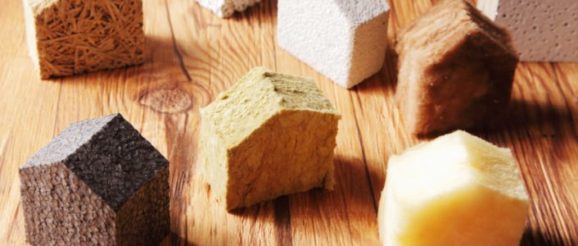7 eco-friendly insulation alternatives for a green home | Inhabitat – Green Design, Innovation, Architecture, Green Building

Insulation is an important part of any home. Not only does it retain heat during the winter by restricting air flow, but it also reduces the cost of heating and cooling throughout the year. For more than a century, most new homes were built with fiberglass insulation, but this can cause many health issues. If you are building a new house or remodeling in the near future, try one of these green home insulation alternatives to make your home safe and healthy.
Sheep’s wool
Not only is sheep’s wool fire retardant, but the material can keep your home warm the same way it helps sheep survive frigid temperatures. In recent years, scientists have figured out how to apply the insulating properties of sheep’s wool to home construction.
The compressed wool fibers form millions of tiny air pockets, and the outer layer is resistant to water while the inner layer absorbs moisture. This helps it generate heat while preventing condensation, and it keeps your home warm in the winter and cool in the summer.
When you use sheep’s wool, you won’t have to adjust your heating and cooling system often, and that will save you energy and money.
Cotton/denim
Because cotton is a natural and renewable resource, it is one of the most eco-friendly insulation options on the market. Leftover blue jean scraps are shredded and recycled into thick batts that fit into your walls just like fiberglass. To make it safe for humans as well as the environment, companies treat the cotton with a borate solution, so the insulation isn’t flammable.
Cotton is also a natural insect repellent, doesn’t contain formaldehyde and doesn’t cause respiratory problems. However, compared to fiberglass, it is incredibly expensive, costing nearly twice as much.
One of the strongest home insulation alternatives, Icynene is a spray foam made out of castor oil that expands about 100 times its volume when you spray it into a wall or ceiling. Not only does it seal leaks and drafts, but it also cancels noise.
During the foaming process, Icynene traps in tiny air bubbles, and when the foam cures, the air remains in place. This is why the insulation works so well. However, the sealing powers of Icynene are so strong, you have to install a ventilation system. Because of the additional requirements, the upfront costs to install Icynene are expensive. However, it will reduce your energy bill so drastically, in the long run, you will save money.
At first glance, this might not sound like a green option, but polystyrene is considered to be green because it helps you save an enormous amount of energy. Polystyrene is a plastic that comes in two forms: rigid foam boards that will add structural integrity to your walls and a spray foam.
This man-made material is 90 percent air, but it is difficult for heat to pass through it, making it excellent for insulation. The legend has it that Samuel Stephens Kistler invented aerogel in 1931 after making a bet with a friend. Kesler bet that he could replace the liquid in a jelly jar without causing the jelly to shrink, and he won by removing the liquid and replacing it with air. This led to aerogel, which is made by removing the liquid from silica under high pressure and temperature.
Aerogel is ultra lightweight and comes in sheets or stickers for easy installation. However, it is pricey, costing up to $2 a foot.
This option actually has a negative carbon footprint, because the finished product is made from the outer bark of oak trees. It is natural, renewable, recyclable and biodegradable, plus it cancels noise and is free of toxins.
If you are looking to minimize the toxins in your house, cellulose is a good choice. Made from recycled newsprint and other paper, it is safe to install. Using this kind of insulation means that the paper in your walls didn’t make its way to a landfill to release harmful greenhouse gases.
When it comes to insulation, there is no right or wrong choice. But there are many different options out there with various qualities, good and bad. Be sure to weigh the pros and cons of each to find the insulation that works best for you and your home.
